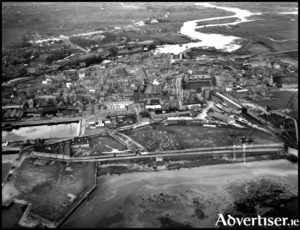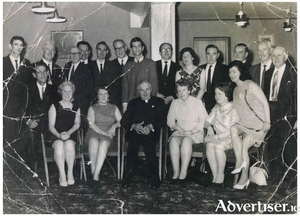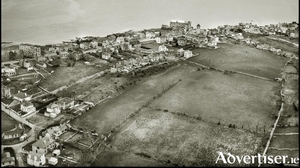The Salmon Weir
Thu, Jan 08, 2026
Galway was originally known as ‘Streamstown’ as the river divided into a series of streams as it moved through the city. All that was to change in the mid-18th century when works were undertaken to improve drainage, to facilitate navigation and to provide waterpower for the many mills in Galway. The primary purpose in improving drainage was to reduce winter water levels in the areas of flooded land which was an ongoing problem.
Read more ...Galway from the air, 1950
Wed, Dec 31, 2025
This wonderful aerial view of the city looking across Lough Athalia was taken c1952. Lough Athalia is the anglicisation of Loch an tSáile, the Salt Lake, a tidal lake. There are so many changes to this cityscape since then, it is hard to know where to begin.
Read more ...The Collegiate Church
Thu, Dec 25, 2025
The Collegiate Church of St. Nicholas is without doubt the only building where a Christmas service has been held regularly for over 700 years. It is the largest medieval parish church in Ireland, cruciform in shape, with a large nave, slightly longer than the chancel, flanked by aisles which are wider than the nave. The aisles lead on to the north and south transepts which meet under the tower.
Read more ...The Galway Market
Thu, Dec 18, 2025
The traditional Galway farmers’ market is mentioned in records as far back as 1260. It has been taking place in the empty space in front of St Nicholas’ Collegiate Church on most Saturdays since. It is an occasion where town meets country, as farming people from the hinterland come into town with their produce, which is of course important for the needs of the townspeople.
Read more ...Shantalla and its people
Thu, Dec 11, 2025
The place-name Shantalla is derived from the Irish ‘Sean Talamh’ meaning old ground, though why Shantalla should be older than the ground around it is a mystery. Maybe a lot of it was never worked and left wild. Sometimes the name was written as Shantallow, and locally it was always known as ‘Shantla’.
Read more ...Street selling in Woodquay
Thu, Dec 04, 2025
Markets and fairs were where town met country years ago, when rural people from the hinterland came into town with their produce and sold it on the streets to the townspeople who needed it. So the city hosted cattle fairs, sheep fairs, horse fairs, hiring fairs, vegetable markets, hay markets, fish markets, sock markets, fowl markets, egg and butter markets. When the country people sold their produce, they would often spend money on necessities they could not produce at home such as flour, tea or sugar. If they did not sell, they had to return home, usually by shank’s mare, with whatever they had to sell, whatever the weather.
Read more ...Irish dancing down the years
Thu, Nov 27, 2025
There is a general lack of specific references to dancing in our older literature but it would be remarkable if there was no dancing in ancient Ireland, if a people with a native taste for music had no knowledge of the kindred art of dancing. There are two Irish words for dance, ‘damhsa’ and ‘rince’. The first is derived from the French ‘danse’ and the second from the English ’rink’ as in skating on ice. The Normans are credited with introducing ‘round dances’ to Ireland.
Read more ...A century of County Galway Libraries
Thu, Nov 20, 2025
In May, 1924, Galway County Council resolved, ‘… the adoption of the Carnegie Rural Libraries Scheme in County Galway, and we, the members, undertake, individually and collectively, to press for the maintenance of the scheme of a County Library rate at the end of the two years during which it has been maintained by the Carnegie Trust’.
Read more ...James Hardiman, historian
Thu, Nov 13, 2025
James Hardiman, who wrote the history of Galway, died on this day, November 13, 1855. He was born in Westport in 1782, the son of Tomás Ó hArgadáin and Marcella Hall. Irish was his first language. The family moved to Galway where his father had a ‘small but respectable shop’. He had hoped to study for the priesthood but he had to give up that idea when he lost his right eye in an accident. He studied law instead in the King’s Inns in 1804, became a solicitor in 1814 and worked in the Public Records Office from 1811-1830.
Read more ...Souvenirs of our industrial past
Thu, Nov 06, 2025
During the 17th century, official money made under the king’s licence was often very scarce and to counteract this some individuals, merchants and borough corporations often issued their own coinage – tokens. These had the issuer’s name or his crest or motto and a statement of what he was – eg, merchant, distiller etc. These pieces were issued between 1650 and 1680 and passed locally as small change. They were readily accepted by locals as they knew the issuers and with virtually no official small change in circulation, the tokens had to suffice. There were 32 different issuers of tokens in Galway city during that time.
Read more ...Claddagh interiors, some 200 years ago
Thu, Oct 30, 2025
William Evans (1798-1877) was the drawing master of Eton College in England, an accomplished artist who exhibited widely in London, Dublin and Paris. He made a number of visits to the west of Ireland in 1835 and 1838 where he produced many finished watercolours and studies, mostly of Counties Galway and Mayo. His subject matter varied from panoramic landscapes to market and street scenes, and what might be called peasant structures and peasant portraits. He painted a lot in Conamara, especially in the vicinity of Renvyle and was among the very first artists to show off this wild remote area in his pictures.
Read more ...Coláiste Éinde
Thu, Oct 23, 2025
On this day, October 23, 1928, Coláiste Éinde (St Enda’s College) opened in an old house belonging to the Blake family in Furbo. It had been founded by the State shortly after the State itself was founded. The aim of the college was to teach boys through the medium of Irish so that they could go on to third level at St Patrick’s Training College, get a secure job as an Irish language teacher and then, in turn, educate a new generation of boys as Gaeilge. The college did not last very long in Furbo as there was some kind of domestic dispute between members of the Blake family and the school had to be evacuated by Christmas 1930, so they moved it to Dublin, to Talbot House on Talbot Street.
Read more ...The canal
Thu, Oct 16, 2025
In 1872, SU Roberts, the Galway County Surveyor, wrote: “The lower lake empties its waters through a delta by three visible outlets: the natural and original shallow, tortuous and rocky Corrib River, navigable for only very small craft and row-boats on the west; the Mionloch Creek, a small stream, on the east and now nearly filled up; and through the boggy island covered with sedge between these two, by means of the “Friar’s Cut”, a canal of about three-quarters of a mile in length, fifty feet wide and twelve deep through the main stream passes. Besides these three streamways, there is a subterranean communication through the cavernous limestone, by means of ‘swallow holes’ near Tír Oileáin on the eastern shore which formerly carried off a large portion of the surplus waters of the lake, and discharged them into the sea near Oranmore”.
Read more ...When motoring came to Galway
Thu, Oct 09, 2025
The first motor car was imported into Ireland in 1896. The early ones were steam-powered and badly suited to Ireland’s climate and roads. There was no surface on the roads, lots of potholes left by horses and animals, and of course pedestrians who were unfamiliar with motor cars. Some thought they were parts of trains that had broken off, noisy and smelly vehicles driven by faceless people – drivers wore goggles and head coverings to keep smoke from the engines and road dust from irritating their eyes and nose. Others thought they were the devil’s work and would bless themselves and say a prayer as these cars went by.
Read more ...Stories about the prince of storytellers
Thu, Oct 02, 2025
As next Monday is the anniversary of Pádraic Ó Conaire’s death we thought to relate some stories about him.
Read more ...When Salthill was a village
Thu, Sep 25, 2025
This photograph of Salthill was taken about 75 years ago by Norman Ashe, a Dublin photographer who specialised in aerial photography. Most aerial images of the area were taken from the sea side but he chose the other direction.
Read more ...St Mary’s: the class of ‘65
Thu, Sep 18, 2025
It was about this time of year, September 1910 that construction work started on the new diocesan college, St Mary’s. Our photograph shows the blessing of the school on August 26 1912, Monsignor Fahey preaching. The first students entered two days later. There were 17 day boys paying £6 per annum and 60 boarders who paid £30 per annum.
Read more ...St Anthony’s and Claddagh Credit Union
Thu, Sep 11, 2025
Benny Byrne and Stephen Deveney often met in Cooke’s Bar for a pint and they invariably ended up wondering about the possibility of starting up a credit union in the Shantalla area. They were greatly encouraged by Nora Herlihy, a Cork lady who had done a great deal to spread the credit union idea. So they wrote a letter to the Galway Observer inviting interest in their idea. They got one reply, from Jack Phelan in Ashe Road. They eventually organised a meeting for the formation of a study group in Benny’s house at 20 Shantalla Place on September 26, 1963.
Read more ...My happiest day in Croke Park
Thu, Sep 04, 2025
I was privileged several times to have been in Croke Park when Galway won All-Irelands but none of them compared to September 7, 1980 when we won our first hurling title in 57 years. All of those years of frustration, of being gallant losers, noble in defeat, worthy opposition, of being classed as also-rans, chokers, of being told we had some of the finest hurlers never to win an All-Ireland, were all forgotten in that never-to-be-forgotten moment when the final whistle went. All of the hard luck stories, the near misses, the controversial defeats, the emptiness, all vanished with the sweet music of that whistle. We had to look at the scoreboard to make sure it was true. Galway 2-15, Limerick 3-9. The tears. The huge outburst of emotion and frenzied celebration was beautifully captured in Stan Shields’ photograph, our first image today.
Read more ...Silkes of William Street West
Thu, Aug 28, 2025
At the beginning of the last century, William Joseph Silke came to Galway from Kilconnell. He had occasion to visit the shop owned by Mrs Teresa Mannix on the corner of Upper Dominick Street and Pump Lane. She was a Macaulay from Scotland and was the widow of a Mr Mannix from Galway. They fell in love and eventually married and together, they had four children, Willy Joe, Michael John, Tess and Annie May.
Read more ...



















